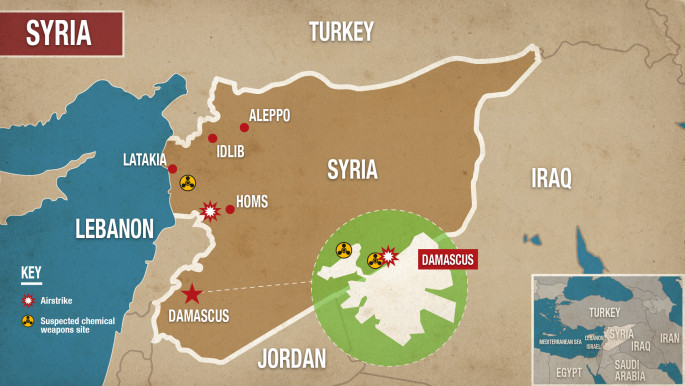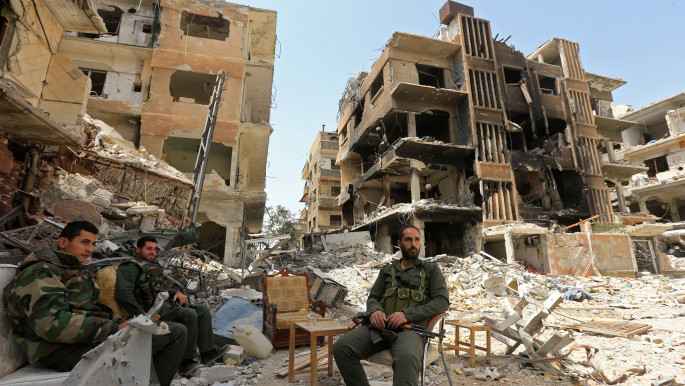'A marathon of pain': April showed the Syrian conflict is as dangerous as ever
All of this signifies that even though the Syrian conflict is almost a decade old it is still as devastating and dangerous as ever.
Assad continues to gain ground
In what has amounted to his biggest victory over the ragtag opposition to his rule since his violent destruction of opposition-held East Aleppo in December 2016, Syrian President Bashar al-Assad reconquered the last major opposition-held bastion near Damascus – Eastern Ghouta.
Eastern Ghouta had been under regime siege for a staggering five years and early this year remained home to about 400,000 people.
Assad began focusing on eradicating the opposition forces in the district in February and, with support from Russian warplanes, killed hundreds of people in the first few days of what ultimately became a seven-week-long offensive.
By late March, with about 130,000 people there already displaced, opposition fighters had begun evacuating the area in bus convoys en masse as it became clear there was no way they could resist such a ferocious assault.
On April 7, at least 70 people perished in a chemical attack in the town of Douma. Eastern Ghouta had previously been the victim of the largest gas attack in the Syrian conflict on August 20, 2013 that left up to 1,400 people dead – an attack that constituted the largest mass-murder since Saddam Hussein infamously killed 5,000 Kurds in one day with poison gas in the town of Halabja on March 16, 1988.
|
|
||||
The next day the Russian military said it had made a deal with the remaining Jaish al-Islam fighters in the city to withdraw their forces, which amounted to 8,000 fighters along with 40,000 of their relatives in the area. By April 12 the area was reportedly under full control of the Syrian Army alongside Russian military police troops.
Eastern Ghouta is largely in ruins following years of bombardment. Its wholesale destruction and the tragic death toll that came with it – nearly 1,500 civilians were killed in the last month of the regime offensive – is a major victory for Assad and gives him control over another strategic swath of Syrian territory. Bolstered by this victory his next target will likely be either Daara Province in the south or Idlib Province in the northwest – where more similar atrocities and yet another humanitarian crisis will likely transpire.
US-led coalition launches more pinprick missile strikes against Damascus
At 4am local time on the morning of April 14 the militaries of the United States, France and the United Kingdom retaliated over the April 7 Douma gas attack by launching over 100 cruise missiles, with average payloads of 1,000 pounds each, at a mere three targets believed to be linked to Syria's chemical weapons programme.
 |
|
| United States, France and the United Kingdom retaliated over the April 7 Douma gas attack by launching over 100 cruise missiles [The New Arab] |
Leaders from all three countries stressed that the attack was aimed at reprimanding Assad for Douma and not toppling his regime.
Read also: Giving comfort in the chaos: Meeting aid worker Madiha Raza
US President Donald Trump channelled former President George W Bush's widely derided premature "Mission Accomplished" declaration in 2003 by tweeting the same phrase in the immediate aftermath of the attack – and then defended the comparison. Even two weeks later it's unclear if Syria's chemical capabilities hitherto April 14 have in any way been affected.
In April 2017 the US launched 59 Tomahawk cruise missiles at Syria's Shayrat airbase in Homs Province in retaliation to a gas attack on the town of Khan Sheikhoun that was reportedly launched from that airbase. In retrospect that attack clearly did not hinder Syria's chemical capabilities nor even permanently destroy and take out of action its sole target, despite the stupendously huge amount of firepower used against it.
Both attacks constituted mere pinprick attacks, the overall impact of which is highly questionable.
While it's unclear if sarin gas, a deadly nerve agent, was used in the Douma attack it's certain that chlorine gas, a choking agent, was. Chlorine, especially when compared with sarin, is extremely easy to produce, especially by state actors, since its primary component is important for water purification.
See also: Photoblog: Syria's Khan Sheikhoun residents mark anniversary of deadly sarin attack
As analyst Michael Knights pointed out: "The regime has been good at using a chemical weapon that has enormous availability and is produced in completely legal, dual-use facilities and vital to the running of any country."
 |
The regime has been good at using a chemical weapon that has enormous availability and is produced in completely legal, dual-use facilities and vital to the running of any country |  |
In light of the strikes Russia said it would reconsider supplying Damascus with long-range S-300 air defence missile systems. Moscow previously decided not to sell this advanced hardware to Syria back in 2013 at the behest of Israel – which feared that the system could hinder their intermittent airstrikes into Syria that invariably target weapon systems it does not want the Iran-backed Hizballah group in Lebanon to obtain.
 |
|
| Syrian pro-government forces sit amidst destroyed buildings in the Eastern Ghouta town of Douma [Getty] |
Cold war between Israel and Iran heats up
On April 9 an Israeli airstrike targeted the T-4 (Tiyas) airbase in central Syria. The blast killed 14 personnel there including, most notably, seven members of Iran's Islamic Revolutionary Guard Corps (IRGC).
The strike was clearly a continuation of an Israeli air campaign that struck 12 Syrian bases on February 14 following the incursion of an Iranian-made drone – reportedly launched from T-4, which is approximately 250 kilometres from the Syrian-Israeli border – into Israeli airspace.
Those strikes resulted in the downing by a Syrian missile of an Israeli F-16 fighter jet just as it re-entered Israeli airspace. The only reason Israel did not continue its bombardments after losing that jet was reportedly because Russian Prime Minister Vladimir Putin, in a furious phone call, warned Israeli Prime Minister Binyamin Netanyahu against doing so.
Russian Foreign Minister Sergei Lavrov also described the April 9 attack as "a very dangerous development." Moscow claims that Israel did not warn its military forces in Syria that it was about to launch an attack. Iran, for its part, vowed to retaliate over the killing of its paramilitary troops.
Another strike, on April 30, was carried out with surface-to-surface missiles, struck an arms depot in Hama province and a military airbase in Aleppo province. According to the Syrian Observatory for Human Rights the Hama facility housed surface-to-surface missiles belonging to Iranian militiamen also present. The attack killed a total of 26, most of them Iranian. In terms of capability and motive Israel is most likely executioner of this latest attack. Iran has denied that any of its troops were killed.
"What our problem is and what we will not allow is for Iranians to establish a base in Syria against Israel," said Israeli Defence Minister Avigdor Lieberman recently.
"An Arab base or navy hub or some base for their ground operations we will not allow," he added. "I think it's also this position that we explain to everybody in the world. We have a political will and determination to protect ourselves.
"Israel does not want war … but if Iran attacks Tel Aviv, Israel will also hit Tehran," Lieberman warned.
His comments come just over two weeks after Ali Shirazi, Iran's Supreme Leader Ayatollah Ali Khamenei's liaison with the IRGC's extraterritorial Quds Force, warned that: "Iran has the capability to destroy Israel and given the excuse, Tel Aviv and Haifa will be razed to the ground."
Lieberman also said that even though Israel disagrees with Russia's policies in Syria it nevertheless respects them.
 |
I really thought 2017 would be the last huge war year, but the crisis has continued at the same ferocity into 2018 |  |
It's worth noting that Israel failed to convince Russia to establish a 60-kilometre buffer zone to keep Iranian militia proxies a certain distance from the de-facto border between Syria and the Israeli-controlled Golan Heights. Russia reportedly said it would only ensure such groups are kept at least five kilometres away from the Israeli frontier.
Furthermore, following his aforementioned conquest of Eastern Ghouta, Assad's next target may well be the Daraa region in southern Syria, where the uprising against his rule began in 2011. A return of Syrian regime forces to these areas could well ultimately include Iranian-backed militia proxies, which would further aggravate Israel and increase the risk of more clashes.
Speaking at the Senate Armed Services Committee on April 26, US Secretary of Defence James Mattis expressed his view that the risk of a confrontation between Israel and Iran in Syria is likely.
"I think that it's very likely in Syria because Iran continues to do its proxy work there through Lebanese Hizballah there and over in Lebanon so I can imagine this sparking something larger," he said.
Furthermore, if Russia goes ahead and supplies Assad with S-300s the Israelis may well try to take them out to deny Assad a formidable weapon to hinder their air operations over Syria.
Conclusion: a tremendous marathon of pain
All these developments signal that the Syrian war will drag on for at least another year or possibly even become the battlefield for an Iranian-Israeli confrontation.
The head of the UN's humanitarian task force for Syria, Jan Egeland, recently lamented the fact that this lengthy war persists after most of the country has been destroyed and 500,000 Syrians lost their lives – and half the country's population has become either displaced or are refugees.
"I really thought 2017 would be the last huge war year, but the crisis has continued at the same ferocity into 2018," he said. "This has become a tremendous marathon of pain."
Paul Iddon is a freelance journalist based in Erbil, Iraqi Kurdistan, who writes about Middle East affairs.
Follow him on Twitter: @pauliddon





 Follow the Middle East's top stories in English at The New Arab on Google News
Follow the Middle East's top stories in English at The New Arab on Google News


